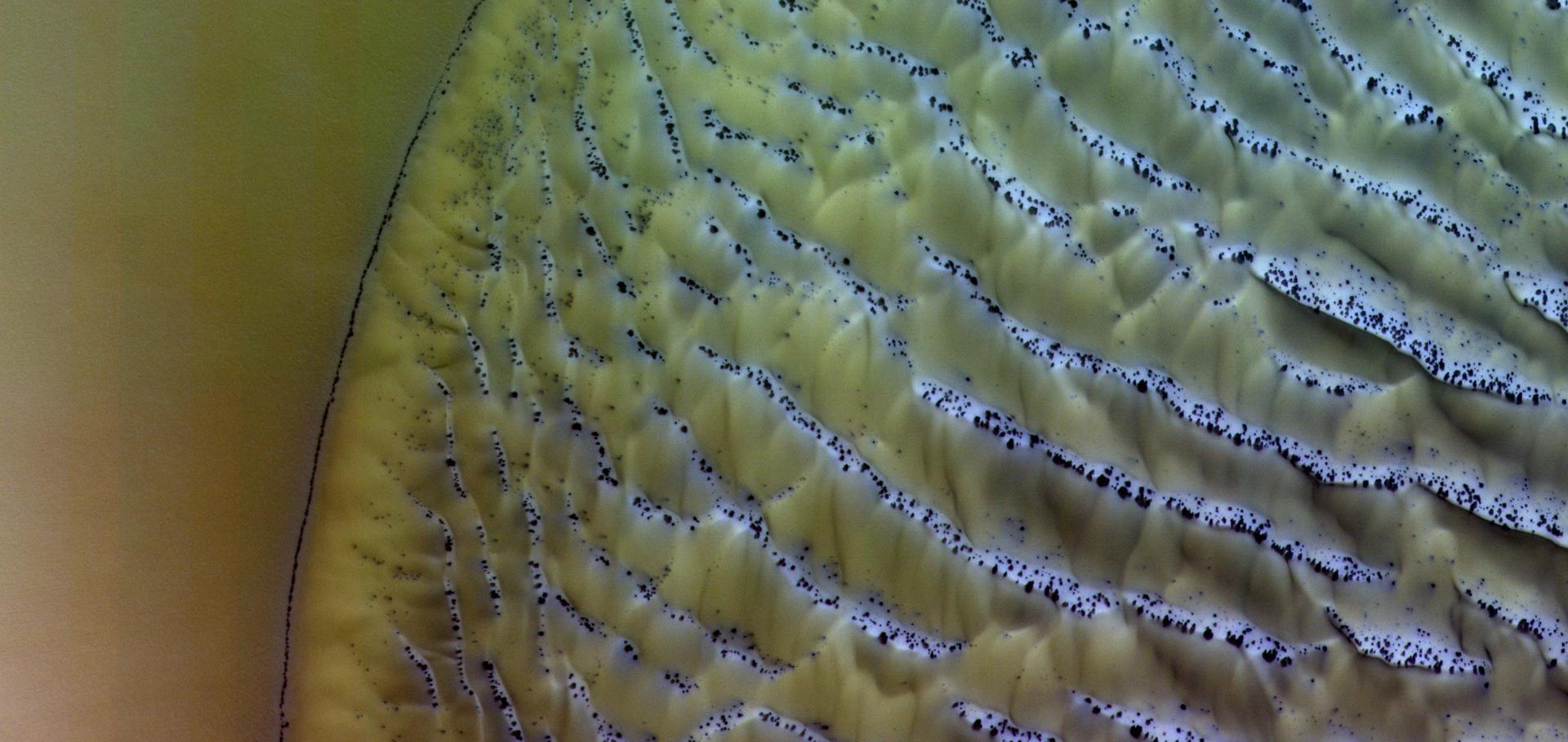A 3D model simulation of hydrogen chloride photochemistry on Mars: Comparison with satellite data
Astronomy & Astrophysics EDP Sciences 699 (2025) a362
Abstract:
Context. Hydrogen chloride (HCl) was independently detected in the Martian atmosphere by the Nadir and Occultation for MArs Discovery (NOMAD) and Atmospheric Chemistry Suite (ACS) spectrometers aboard the ExoMars Trace Gas Orbiter (TGO). Photochemical models show that using gas-phase chemistry alone is insufficient to reproduce these data. Recent work has developed a heterogeneous chemical network within a 1D photochemistry model, guided by the seasonal variability in HCl. This variability includes detection almost exclusively during the dust season, a positive correlation with water vapour, and an anticorrelation with water ice. Aims. The aim of this work is to show that incorporating heterogeneous chlorine chemistry into a global 3D model of Martian photochemistry with conventional gas-phase chemistry can reproduce spatial and temporal changes in hydrogen chloride on Mars, as observed by instruments aboard the TGO. Methods. We incorporated this heterogeneous chlorine scheme into the Mars Planetary Climate Model (MPCM). After some refinements to the scheme, mainly associated with it being employed in a 3D model, we used it to model chlorine photochemistry during Mars Years (MYs) 34 and 35. These two years provide contrasting dust scenarios, with MY 34 featuring a global dust storm. We also examined correlations in the model results between HCl and other key atmospheric quantities, as well as production and loss processes, to understand the impact of different factors driving changes in HCl. Results. We find that the 3D model of Martian photochemistry using the proposed heterogeneous chemistry is consistent with the changes in HCl observed by ACS in MY 34 and MY 35, including detections and 70% of non-detections. For the remaining 30% of non-detections, model HCl is higher than the ACS detection limit due to biases associated with water vapour, dust, or water ice content at these locations. As with previous 1D model calculations, we find that heterogeneous chemistry is required to describe the loss of HCl, resulting in a lifetime of a few sols that is consistent with the observed seasonal variation in HCl. As a result of this proposed chemistry, modelled HCl is correlated with water vapour, airborne dust, and temperature, and anticorrelated with water ice. Our work shows that this chemical scheme enables the reproduction of aphelion detections in MY 35.Global Distribution and Seasonality of Martian Atmospheric HCl Explained Through Heterogeneous Chemistry
Geophysical Research Letters Wiley 52:6 (2025) e2024GL111059
Abstract:
Recent observations from the ExoMars Trace Gas Orbiter (TGO) have revealed the presence of hydrogen chloride (HCl) in the martian atmosphere. HCl shows strong seasonality, primarily appearing during Mars' perihelion period before decreasing faster than projected from photolysis and gas‐phase chemistry. HCl profiles also display local anti‐correlation with water ice aerosol. One candidate explanation is heterogeneous chemistry. We present the first results from a heterogeneous chlorine chemistry scheme incorporated into a Mars global climate model (GCM), with atmospheric dust/water ice parameterized as an HCl source/sink respectively. Results were compared against a Mars GCM with gas‐phase only chlorine chemistry and observations from TGO's Atmospheric Chemistry Suite. We found that the heterogeneous scheme significantly improved the modeled HCl seasonal, latitudinal, and vertical distribution, supporting a crucial role for heterogeneous chemistry in Mars' chlorine cycle. Remaining discrepancies show that further work is needed to characterize the exact aerosol reactions involved.Global Transport of Chlorine Species in the Martian Atmosphere and the Resulting Surface Distribution of Perchlorates
Journal of Geophysical Research: Planets American Geophysical Union 130:3 (2025) e2024JE008537
Abstract:
Recent observations by instruments aboard the ExoMars Trace Gas Orbiter (TGO) have revealed the seasonal presence of hydrogen chloride ( HCl $\text{HCl}$ ) in the Martian atmosphere. This discovery may have important implications for Martian photochemistry as chlorine species are chemically active, and it may provide a link between the atmosphere and known surface reservoirs of chlorine. However, the global distribution of atmospheric HCl $\text{HCl}$ is unknown beyond the very sparse TGO observations, and the source and sink processes driving the observed variability of HCl $\text{HCl}$ are not currently understood. We used a Martian global climate model to investigate, for the first time, the spatial distribution of chlorine species in the Martian atmosphere, and the resulting distribution of surface perchlorates formed via adsorption of atmospheric chlorine species. We adapted an existing Martian photochemical scheme to include gas‐phase chlorine chemistry with HCl as the source species, and the resulting atmospheric perchloric acid was allowed to deposit onto the Martian surface via a heterogeneous adsorption scheme. We found that odd‐oxygen ( O , O 3 $\mathrm{O},{\mathrm{O}}_{3}$ ) and odd‐hydrogen ( H , OH , HO 2 $\mathrm{H},\text{OH},{\text{HO}}_{2}$ ) species play a major role in controlling the distribution of atmospheric chorine species. Surface perchlorate deposition was found to occur preferentially at high latitudes; in the tropics, the perchlorate distribution was anti‐correlated with surface thermal inertia and agreed qualitatively with observations of surface chlorine. Our model predicted a relative enhancement of HCl in polar regions, but it did not reproduce the observed strong seasonality of HCl, suggesting that heterogeneous chemistry may be required to explain the observed chlorine cycle.Relationships Between HCl, H 2 O, Aerosols, and Temperature in the Martian Atmosphere: 2. Quantitative Correlations
Journal of Geophysical Research: Planets American Geophysical Union 129:8 (2024) e2024JE008351
Abstract:
The detection of hydrogen chloride (HCl) in the atmosphere of Mars was among the primary objectives of the ExoMars Trace Gas Orbiter (TGO) mission. Its discovery using the Atmospheric Chemistry Suite mid‐infrared channel (ACS MIR) showed a distinct seasonality and possible link to dust activity. This paper is part 2 of a study investigating the link between HCl and aerosols by comparing gas measurements made with TGO to dust and water ice opacities measured with the Mars Climate Sounder (MCS). In part 1, we showed, and compared, the seasonal evolution of vertical profiles of HCl, water vapor, temperature, dust opacity, and water ice opacity over the dusty periods around perihelion (solar longitudes 180°–360°) across Mars years 34–36. In part 2, we investigated the quantitative correlations in the vertical distribution between each quantity, as well as ozone. We show that there is a strong positive correlation between HCl and water vapor, which is expected due to fast photochemical production rates for HCl when reacting with water vapor photolysis products. We also show a strong positive correlation between water vapor and temperature, but are unable to show any correlation between temperature and HCl. There are weak correlations between the opacities of dust and water ice, and dust and water vapor, but only very low correlations between dust and HCl. We close with a discussion of possible sources and sinks and that interactions between HCl and water ice are the most likely for both, given the inter‐comparison.Relationships Between HCl, H 2 O, Aerosols, and Temperature in the Martian Atmosphere: 1. Climatological Outlook
Journal of Geophysical Research: Planets American Geophysical Union 129:8 (2024) e2024JE008350


